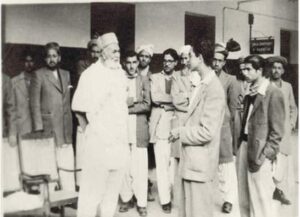By: Naqeeb Ullah Tareen
The right to seek asylum forms one of the most vital pillars of international humanitarian and human rights law. It ensures protection for individuals escaping persecution, conflict, or serious human rights violations in their home countries. This study explores the legal foundations of asylum as a human right within international law and critically assesses how this principle is implemented — or neglected — in Pakistan, a state that continues to host millions of refugees despite not being a signatory to the 1951 Refugee Convention or its 1967 Protocol.
The article examines Pakistan’s refugee and asylum policies, highlighting the significant gap between international legal commitments and the country’s domestic legal and administrative frameworks. It also proposes ways Pakistan can align its practices with global human rights norms to better safeguard the dignity and safety of asylum seekers.
Theoretical Framework: Asylum in International Law
The modern understanding of asylum as a human right emerged after World War II, culminating in the adoption of Article 14(1) of the Universal Declaration of Human Rights (UDHR), which declares that “everyone has the right to seek and enjoy asylum from persecution.” Although the UDHR is not legally binding, it provided the moral and legal basis for the 1951 Refugee Convention and the 1967 Protocol, both of which define who qualifies as a refugee and outline the responsibilities of states towards them.
Key international principles include:
- Non-Refoulement (Article 33): States must not return individuals to a country where their life or freedom would be at risk.
- Non-Discrimination (Article 3): Refugees must be treated equally regardless of race, religion, or nationality.
- Access to Justice (Article 16): Refugees have the right to access courts and legal assistance.
These principles, reinforced by other instruments such as the International Covenant on Civil and Political Rights (ICCPR) and the Convention Against Torture (CAT), have become cornerstones of modern international refugee protection law.
Pakistan’s Approach: Between Humanitarianism and Legal Vacuum
Pakistan’s response to asylum seekers represents a paradox — the country has shown immense humanitarian generosity in hosting refugees, especially Afghans, for over four decades, yet it lacks a domestic legal framework to regulate asylum procedures.
1. Absence of a National Refugee Law:
Pakistan is not party to the 1951 Refugee Convention or its 1967 Protocol. The existing Foreigners Act of 1946 governs all non-citizens and does not recognize refugees or protect them from refoulement. As a result, asylum seekers face the constant threat of arbitrary detention, deportation, or harassment due to the lack of legal recognition.
2. Role of the UNHCR:
In the absence of a formal state-run asylum system, the United Nations High Commissioner for Refugees (UNHCR) plays a key role in conducting Refugee Status Determination (RSD) for non-Afghan asylum seekers. Under a 1993 cooperation agreement, Pakistan generally respects UNHCR’s decisions, allowing recognized refugees to stay temporarily. However, since this status is not codified in Pakistani law, these individuals remain legally vulnerable.
3. Afghan Refugees and Deportation Policy:
Pakistan has hosted millions of Afghan refugees since 1979, many of whom possess Proof of Registration (PoR) cards that grant temporary protection. However, recent government actions — including the deportation drive launched in late 2023 against undocumented foreigners — have raised serious human rights concerns. The extension of PoR cards only until June 30, 2025, has intensified fears of mass deportations and violations of the principle of non-refoulement.
Challenges and Contradictions
Pakistan’s asylum policy is largely ad hoc and reactive, shaped by political, security, and diplomatic pressures rather than a consistent legal framework. While the country has provided de facto protection to millions of refugees, this generosity lacks legal permanence. Refugees remain in a state of legal uncertainty, with limited access to education, healthcare, or employment.
This disconnect between international obligations and domestic realities undermines the spirit of human rights law. Without a structured legal framework, Pakistan also struggles to attract long-term international support or create sustainable refugee management systems.
Recommendations: Towards a Human Rights-Based Asylum System
To bridge the gap between theory and practice, and to ensure that asylum is recognized as a genuine human right, Pakistan should consider the following measures:
- Adopt a Comprehensive Asylum Law:
Enact national legislation defining refugees in accordance with international standards, ensuring fair asylum procedures and codifying non-refoulement as a legal obligation. - Consider Ratifying the 1951 Refugee Convention and 1967 Protocol:
Accession would demonstrate Pakistan’s commitment to global human rights and allow for stronger cooperation with international agencies. - Institutionalize UNHCR’s Role:
Incorporate the 1993 MoU into national law to ensure transparency and legal consistency in refugee protection and status determination. - Guarantee Access to Basic Services:
Ensure asylum seekers and refugees have access to healthcare, education, and employment, aligning domestic policy with international human rights standards. - Promote Awareness and Tolerance:
Launch national awareness programs to combat xenophobia and promote social cohesion, helping the public understand the humanitarian dimension of asylum.
Conclusion
The right to asylum is deeply rooted in the principles of human dignity and protection from persecution. In Pakistan, despite a long tradition of humanitarian assistance, the absence of a formal asylum framework leaves thousands of refugees vulnerable and unprotected.
By integrating international human rights standards into domestic law and policy, Pakistan can transform its goodwill into legally guaranteed protection — ensuring that the human right to asylum becomes not merely an international ideal, but a practical reality for all those seeking safety within its borders.






